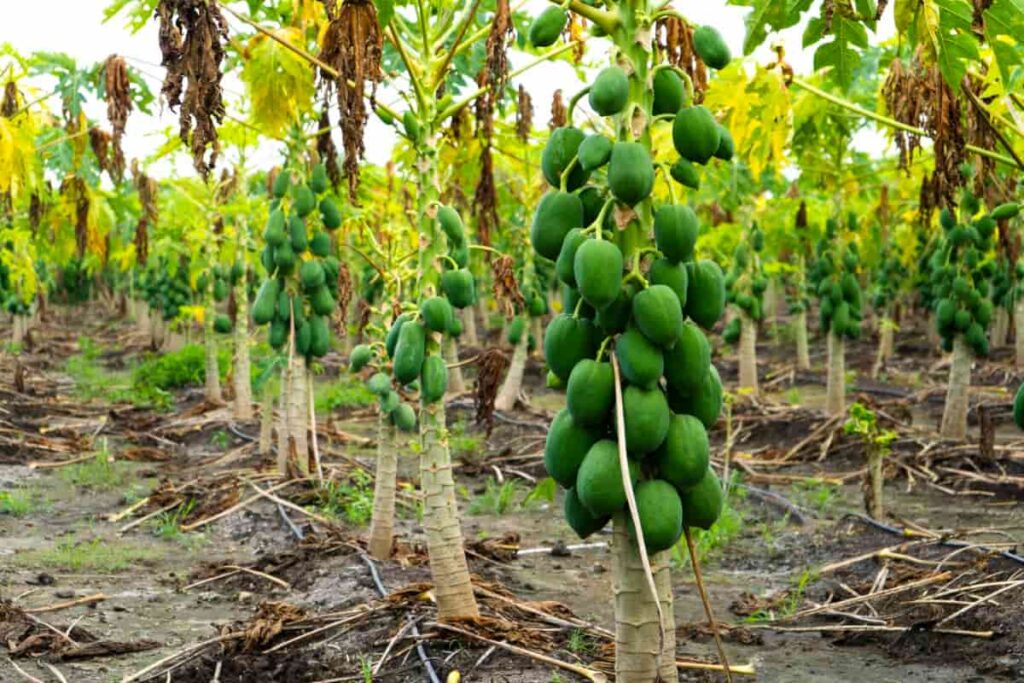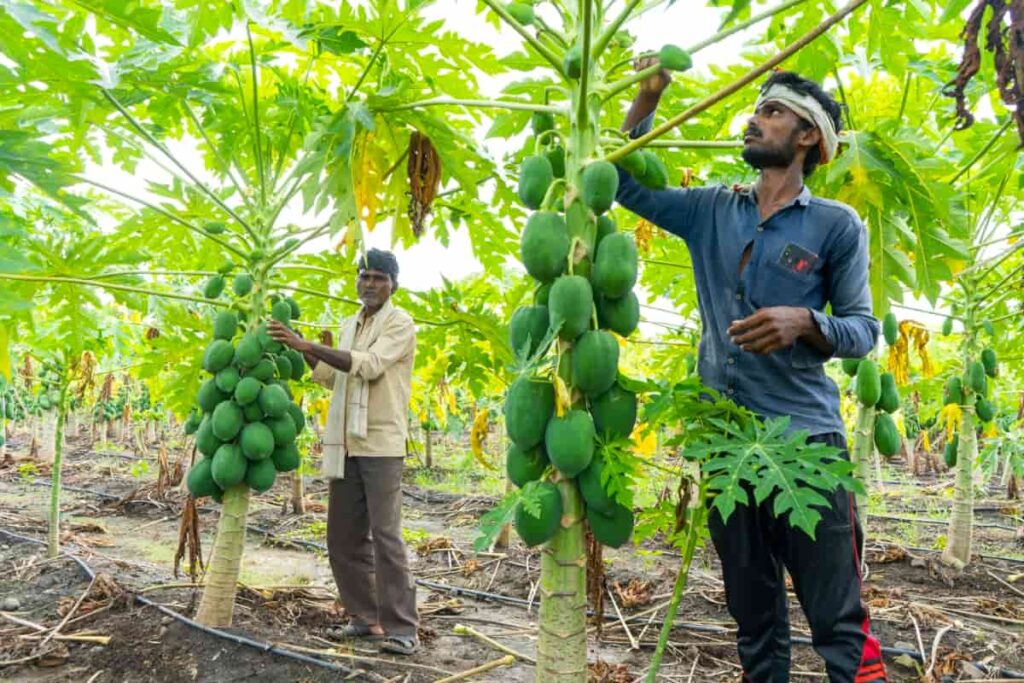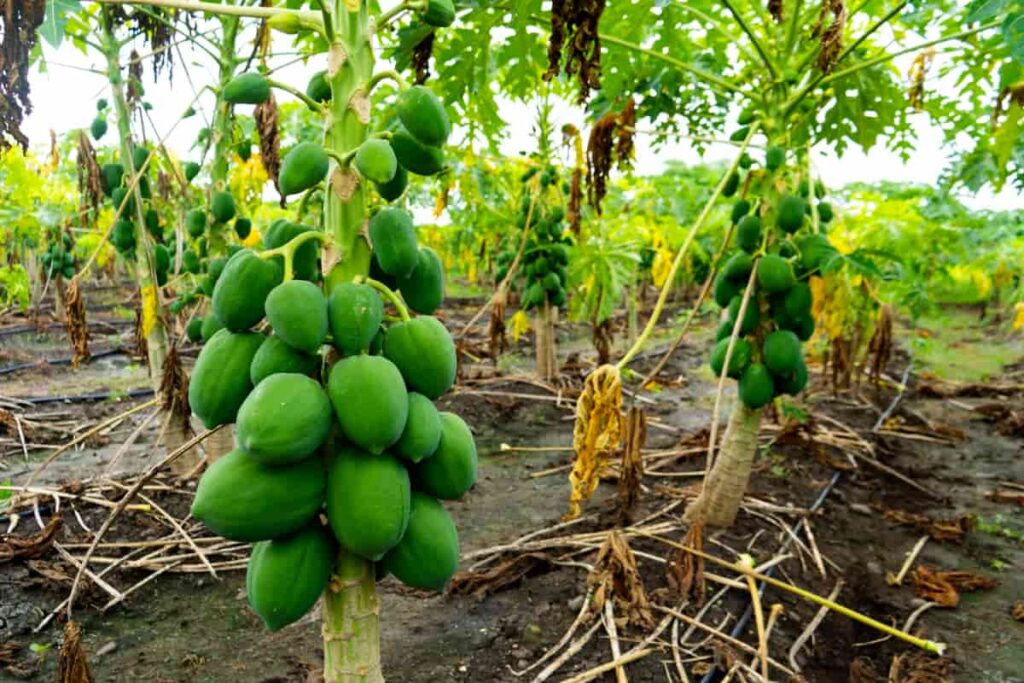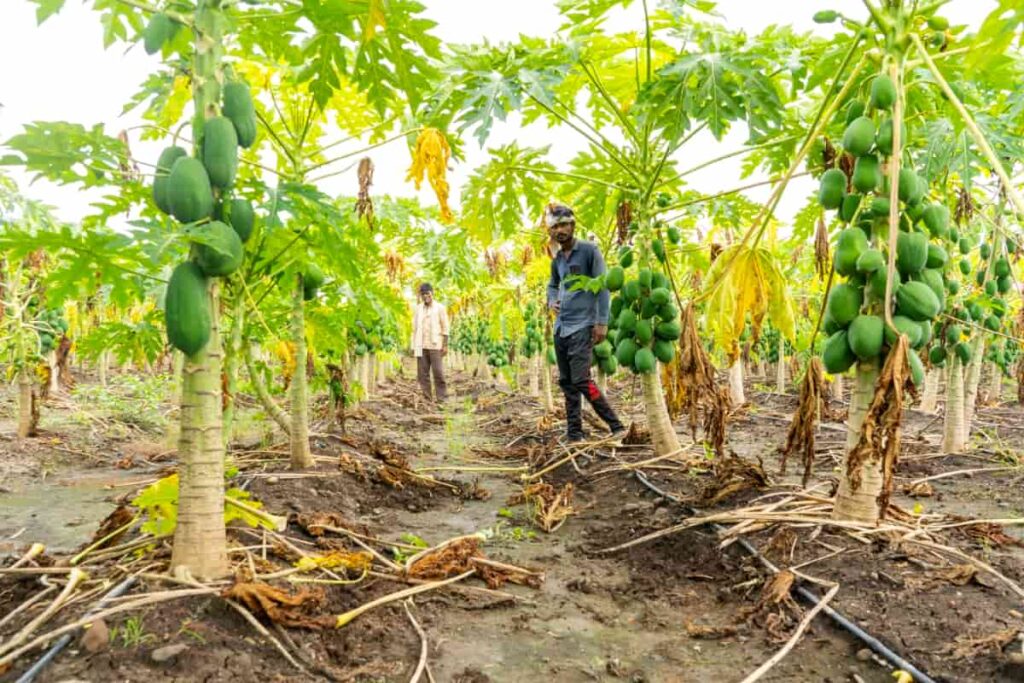Papaya, also known as Carica Papaya, is not only a delicious tropical fruit but also a plant with immense economic value. Leaf Curl Virus is a common problem that affects Papaya plants, causing significant damage to their growth and productivity. The symptoms of the Leaf Curl Virus in Papaya include curling and distortion of leaves, stunted growth, yellowing or reddening of foliage, and reduced fruit production. Several preventive measures can help manage the Leaf Curl Virus in Papaya.

Leaf Curl Virus Treatment in Papaya
Understanding Leaf Curl Virus in Papaya
Symptoms and Diagnosis
The main symptom of the leaf curl virus is the curling and distortion of leaves. Infected leaves often appear crinkled or puckered, with yellowing or mottling on their surface. Another symptom to look out for is the presence of whiteflies on the undersides of infected leaves. To diagnose leaf curl virus in Papaya plants, it’s crucial to conduct visual inspections regularly. Look for signs such as curled leaves, yellowing or mottling patterns, and an abundance of whiteflies.
Causes and Transmission
Leaf Curl Virus in Papaya is caused by a group of viruses known as begomoviruses. These viruses are transmitted through the feeding activity of whiteflies, specifically Bemisia tabaci. The whiteflies act as vectors, carrying the virus from infected plants to healthy ones. The transmission process begins when the whitefly feeds on an infected plant.
When the whitefly moves on to feed on another plant, it injects saliva containing viral particles into that plant’s tissues. This introduces the virus into a new host plant, where it can spread and cause infection. It is important to note that not all whiteflies carry or transmit the Leaf Curl Virus.
Preventive Measures
Cultivating Resistant Varieties
Resistant varieties are specifically bred to withstand and combat diseases like Leaf Curl Virus. There are several Papaya-resistant varieties available in the market today that have shown promising results against the leaf curl virus. The popular resistant varieties are the ‘Sunrise Solo’ variety, and ‘Red Lady’. Other notable resistant varieties include ‘Tainung 1’, ‘Maradol Roja,’ and ‘Waimanalo.’
Implementing Crop Rotation
Crop rotation is a vital practice to control and manage leaf curl virus in Papaya. The idea behind crop rotation is to prevent the buildup of pathogens and pests that target specific plants. In the case of the leaf curl virus in Papaya, rotating with non-host crops helps break the disease cycle by depriving it of its preferred host plant. To implement crop rotation, farmers should select suitable non-host crops, such as legumes or grains, to grow alongside Papaya.
Identification of Infected Plants
Visual Inspection Techniques
Visual inspection is one of the most important techniques for identifying infected plants affected by the Leaf Curl Virus in Papaya. When conducting visual inspections, pay close attention to the leaves and stems of the Papaya plant. Look for symptoms such as curling or twisting of leaves, yellowing or discoloration, stunted growth, and distorted fruit development. These are all indicators that the plant may be infected with Leaf Curl Virus.
Laboratory Testing for Confirmation
One way to confirm if your Papaya plants are infected with leaf curl virus is through laboratory testing. During laboratory testing, experts examine these samples under controlled conditions using specific techniques. Additionally, advanced diagnostic methods like PCR (Polymerase Chain Reaction) can be utilized to detect viral DNA in the plant tissue accurately.
This highly sensitive technique helps identify even low levels of infection. Although laboratory testing may incur some costs and require additional time, it provides concrete evidence about the presence of leaf curl virus in your Papaya plantation.
Removal and Disposal of Infected Plants
Safe Removal Practices
Removal and disposal of infected plants is a crucial step in managing the leaf curl virus in Papaya. By promptly removing and safely disposing of infected plants, we can effectively prevent the spread of the virus to healthy plants. To ensure safe removal practices, it is important to follow certain guidelines. Always wear protective gloves and clothing while handling infected plants to avoid direct contact with the virus.
Disposal Methods to Prevent Spread
Proper disposal of infected plants is crucial in preventing the spread of the Leaf Curl Virus in Papaya. Ensure that you wear gloves while handling infected plants. This will help prevent accidental transfer of the virus to healthy plants or yourself. Once you have removed the infected plant from your garden, it’s essential not to compost it.
In case you missed it: Papaya Farming Information Guide

Controlling Whitefly Populations
Organic Control Methods
These tiny insects may seem harmless, but they can cause damage to the plant leaves if left unchecked. One method is to introduce natural predators of whiteflies into your garden. Another organic approach is using neem oil or insecticidal soap. Additionally, applying good cultural practices such as proper irrigation techniques and optimal plant spacing can also play a role in reducing whitefly populations.
Chemical Insecticides and Their Safe Use
Before applying any insecticide, it is essential to follow the instructions carefully by the manufacturer. It’s also important to choose insecticides that are specifically labeled for use on Papaya plants and target whiteflies, which are known vectors of the virus. Using a broad-spectrum insecticide may harm beneficial insects that help control pest populations naturally.
Cultural Practices for Disease Management
Proper Irrigation Techniques
By providing the right amount of water at the right time, we can help prevent the spread and development of the Leaf Curl Virus. When it comes to irrigation, it’s important to strike a balance. Overwatering can create excess moisture, which creates an ideal environment for disease-causing pathogens to thrive.
On the other hand, underwatering can stress the plants and weaken their natural defenses. Watering during cooler periods, like early morning or late afternoon, helps reduce evaporation and allows foliage to dry before nightfall when temperatures drop, minimizing prolonged leaf wetness that encourages disease development.
Optimal Plant Spacing
It depends on various factors such as cultivar size, soil fertility, and climate conditions. Generally, a spacing range of 6-8 feet between rows with a 3-5 feet distance between individual plants is recommended. Proper plant spacing not only reduces disease incidence but also promotes healthier growth by allowing each tree sufficient access to sunlight, nutrients, and water resources.
Chemical Treatments
Suitable Fungicides and Virucides
Fungicides and virucides are commonly used to control the spread of this devastating virus. These chemical solutions work by targeting the pathogens responsible for causing the disease. Choosing the right fungicide or virucide is essential for effective treatment. Some common options include copper-based compounds, systemic insecticides, and broad-spectrum antiviral agents.
Application Guidelines and Safety
Make sure to carefully read and follow the instructions provided on the packaging of any chemical fungicides or virucides you plan to use. These products can be effective in controlling whitefly populations and managing the virus, but they must be used correctly for optimal results. Always wear appropriate protective gloves, goggles, and a mask when handling these chemicals.
Biological Control Methods
Utilizing Beneficial Insects
Beneficial insects are predators that feed on pests like whiteflies, which are known to transmit the virus. By introducing these insect allies into your Papaya plantation, you can help keep whitefly populations in check and reduce the risk of virus transmission. Implementing biological control methods not only reduces reliance on chemical treatments but also helps maintain a healthy ecological balance in your Papaya orchard.
Natural Predators of Whiteflies
These helpful creatures are nature’s way of keeping whitefly populations without the need for harmful chemicals. The main predators are ladybugs, lacewing, hoverflies, and parasitic wasps. By encouraging these natural predators in your garden through companion planting and providing a habitat conducive for them to thrive, you can effectively manage the presence of whiteflies in your Papaya crop without resorting to harmful chemical treatments.
In case you missed it: High-yield Hybrid Papaya Varieties in India: How to Grow, Fertilizers, Pests, and Diseases

Monitoring and Regular Inspection
Setting up Traps for Early Detection
By setting up traps for early detection, you can identify whitefly populations and take immediate action to prevent the spread of the leaf curl virus. The effective method is to place yellow sticky traps near your Papaya plants. Regularly inspect these traps and count the number of trapped insects. To enhance your monitoring efforts, consider using magnifying tools such as hand lenses or magnifying glasses.
Schedule and Techniques for Regular Monitoring
By setting up traps and regularly inspecting the plants, you can catch any signs of whitefly infestations or viral symptoms early on. This allows for quick intervention and prevents the spread of the virus to healthy plants. Regularly inspect both sides of leaves, new growth, and stems for signs of infection.
In case you missed it: Best Fertilizer for Red Lady Papaya: Schedule of Organic, Liquid, Natural, Homemade, NPK Fertilizers

Conclusion
Leaf Curl Virus infection can cause severe damage to the leaves, leading to reduced fruit production. Leaf Curl Virus treatment is of utmost importance in the cultivation of Papaya plants. This viral infection can cause severe damage to the plant leaves, stems, and fruits, leading to reduced yield and even death in some cases. Therefore, implementing effective treatment methods is crucial for maintaining healthy Papaya crops.
- Broccoli Varieties: Choosing the Right Cultivars for Your Farm
- How to Raise Pigs in Your Own Backyard: A Comprehensive Guide
- Budget Friendly Sheep Shed Ideas: Cheap and Low-Cost Tips
- How Much Do Cattle Farmers Make: Revenue Streams in Cattle Farming
- Management Pests and Diseases in Your Cotton Field
- Sheep Farming Business Plan for Beginners
- Aquaponic Farming at Home: A Step-By-Step Guide
- Profitable Village Farming Business Ideas in 2024
- High-Yield Aquaculture: Fast-Growing Fish for Farming
